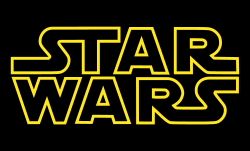
Return of the Jedi is a 1983 American epic space opera film that is the sequel to Star Wars (1977) and The Empire Strikes Back (1980). It is the third installment in the original Star Wars trilogy and the sixth chronological film in the "Skywalker Saga". It is directed by Richard Marquand based on a screenplay by Lawrence Kasdan and George Lucas from a story by Lucas, who was also the executive producer. The film follows the ongoing struggle between the malevolent Galactic Empire and the freedom fighters of the Rebel Alliance. As the Rebels attempt to destroy the Empire's second Death Star, Luke Skywalker hopes to bring his father, Darth Vader, back from the dark side of the Force. The film stars Mark Hamill, Harrison Ford, Carrie Fisher, Billy Dee Williams, Anthony Daniels, David Prowse, Kenny Baker, Peter Mayhew and Frank Oz.
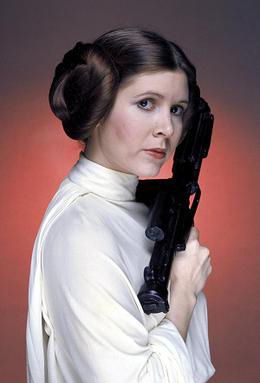
Princess Leia Organa is a fictional character and one of the main characters in the Star Wars franchise, portrayed by Carrie Fisher. Introduced in the original Star Wars film in 1977, Leia is princess of the planet Alderaan, a member of the Imperial Senate and an agent of the Rebel Alliance. She thwarts the sinister Sith Lord Darth Vader and helps bring about the destruction of the Empire's cataclysmic superweapon, the Death Star. In The Empire Strikes Back (1980), Leia commands a Rebel base and evades Vader as she falls in love with the smuggler Han Solo. In Return of the Jedi (1983), Leia helps in the operation to rescue Han from the crime lord Jabba the Hutt and is revealed to be Vader's daughter and the twin sister of Luke Skywalker.

Luke Skywalker is a fictional character and the protagonist of the original film trilogy of the Star Wars franchise created by George Lucas. Portrayed by Mark Hamill, Luke first appeared in Star Wars (1977), and he returned in The Empire Strikes Back (1980) and Return of the Jedi (1983). Over three decades later, Hamill returned as Luke in the Star Wars sequel trilogy, with a cameo in The Force Awakens (2015) before playing a major role in The Last Jedi (2017) and The Rise of Skywalker (2019). He later played a digitally de-aged version of the character in the Disney+ series The Mandalorian, appearing in the second-season finale, which premiered in 2020, and The Book of Boba Fett, in the sixth episode, released in 2022.
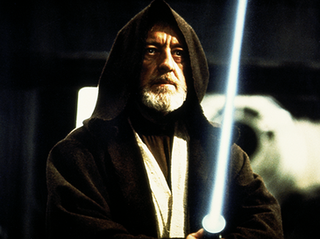
Obi-Wan Kenobi is a fictional character in the Star Wars franchise. Within the original trilogy, Obi-Wan is a Jedi Master as a supporting character and is portrayed by English actor Alec Guinness. In the later-released prequel trilogy, a younger version of the character serves as one of the two main protagonists, alongside Anakin Skywalker, and is portrayed by Scottish actor Ewan McGregor. In the original trilogy he is introduced as Ben Kenobi, an alias he uses while in hiding from the Empire. He is a mentor to Luke Skywalker, to whom he introduces the ways of the Jedi. After sacrificing himself in a duel against Darth Vader, Obi-Wan guides Luke through the Force in his fight against the Galactic Empire. In the prequel trilogy, set two decades earlier, he is initially a Padawan (apprentice) to Jedi Master Qui-Gon Jinn, and later mentor and friend of Luke's father Anakin, who falls to the dark side of the Force and becomes Vader. The character briefly appears in the sequel trilogy as a disembodied voice, speaking to protagonist Rey, and serving as the namesake of Ben Solo. He is frequently featured as a main character in various other Star Wars media, including the streaming television miniseries Obi-Wan Kenobi, in which McGregor reprised the role.
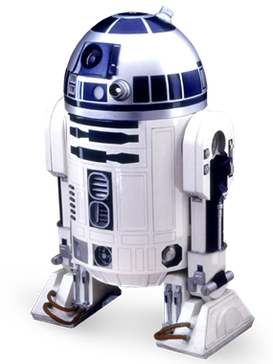
R2-D2 or Artoo-Detoo is a fictional robot character in the Star Wars franchise created by George Lucas. He has appeared in ten of the eleven theatrical Star Wars films to date, including every movie in the original trilogy, prequel trilogy, and sequel trilogy. At various points throughout the course of the films, R2, an astromech droid, is a friend to C-3PO, Padmé Amidala, Anakin Skywalker, Leia Organa, Luke Skywalker, and Obi-Wan Kenobi. R2-D2 and his companion C-3PO are the only characters to appear in every theatrical Star Wars film, with the exception of Solo: A Star Wars Story (2018).

C-3PO or See-Threepio is a humanoid robot character in the Star Wars franchise who appears in every movie of the original trilogy, the prequel trilogy and the sequel trilogy. Built by Anakin Skywalker, C-3PO was designed as a protocol droid intended to assist in etiquette, customs, and translation, boasting that he is "fluent in over six million forms of communication". Along with his astromech droid counterpart and friend R2-D2, C-3PO provides comic relief within the narrative structure of the films, and serves as a foil. Anthony Daniels has portrayed the character in eleven of the twelve theatrical Star Wars films released to date, with the exception of Solo: A Star Wars Story, where the character does not appear.

The Skywalker family is a fictional legendary human family in the Star Wars franchise. Within the series' fictional universe, the Skywalkers are presented as a bloodline with strong inherent capabilities related to the Force and sometimes lightsaber skills. Luke Skywalker, his twin sister Princess Leia Organa, and their father Darth Vader are central characters in the original Star Wars film trilogy. Darth Vader, in his previous identity as Anakin Skywalker, is a lead character in the prequel film trilogy and so is his wife and the twins' mother Padmé Amidala; while his mother Shmi is a minor character in the first and second films respectively. Leia and Han Solo's son, Ben Solo, renamed himself Kylo Ren and is the main antagonist in the sequel film trilogy, while they and Luke serve as supporting characters. Shmi, Padmé, and Han are the only members who are not Force-sensitive. The Skywalker bloodline, alongside the Palpatine bloodline, are the two bloodlines that are the strongest with the Force.

Anthony Daniels is an English actor and mime artist, best known for playing C-3PO in 11 Star Wars films. He is the only actor to have either appeared in or been involved with all theatrical films in the series, and has been involved in many of their spin-offs, including television series, video games, and radio serials.

Star Wars: Shadows of the Empire is a 1996 multimedia project created by Lucasfilm. The idea was to create a story set between the films The Empire Strikes Back and Return of the Jedi, and to explore all commercial possibilities of a full motion picture release without actually making a film. The venture was intended to reinvigorate interest in the franchise ahead of the theatrical Special Editions of the Star Wars trilogy released the following year.
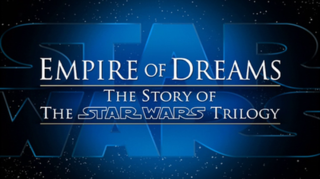
Empire of Dreams: The Story of the Star Wars Trilogy is a 2004 documentary film directed by Kevin Burns and narrated by Robert Clotworthy. It documents the making of the original Star Wars trilogy: Star Wars (1977), The Empire Strikes Back (1980), and Return of the Jedi (1983), and their impact on popular culture.
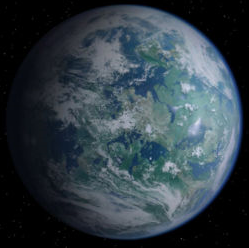
Alderaan is a fictional planet featured in the Star Wars franchise. It is blue-green in appearance, depicted as a terrestrial planet with humanoid inhabitants, and characterized by a peaceful culture. It is the home planet of Princess Leia Organa, one of the lead characters in the film series, as well as former Rebel shock trooper Cara Dune. In the original 1977 film, Alderaan is destroyed by the Death Star's superlaser.
Star Wars Infinities is a graphic novel trilogy published by Dark Horse Comics from 2002 to 2004. It tells a non-canon alternate version of each film in the original Star Wars trilogy in which a point of divergence occurs and changes the outcome of the story. Each individual Infinities story is unrelated to the others and is set within the timeline of their original film.
Return of the Ewok is an unreleased 1982 mockumentary short, written, produced and directed by David Tomblin, starring Warwick Davis as himself in a fictionalized account of how he got the role of Wicket W. Warrick in Return of the Jedi.

The Empire Strikes Back is a science-fiction novelization written by Donald F. Glut and first published by Del Rey. It is based on the screenplay to the film of the same name by Leigh Brackett and Lawrence Kasdan. Along with the film, it introduces new characters, most notably Lando Calrissian and Boba Fett.
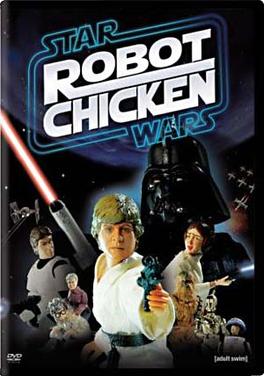
"Robot Chicken: Star Wars" is a 2007 episode of the television comedy series Robot Chicken, airing as a one-off special during Cartoon Network's Adult Swim block on June 17, 2007. It was released on DVD on July 22, 2008.

Jabba Desilijic Tiure, more commonly known as Jabba the Hutt, is a fictional character and major antagonist in the Star Wars franchise. Created by George Lucas, Jabba is voiced by Larry Ward with several puppeteers inside a one-ton puppet portraying him in Return of the Jedi. He was originally supposed to first appear in Star Wars (1977) as a stop motion character with Declan Mulholland as his stand-in. Jabba was later added into the film as a CGI character when it was re-released in Special Edition in 1997. He also appears in the prequel movie The Phantom Menace. The character is a large slug-like creature based on annelid worms and originally designed as an apelike figure.

Han Solo is a fictional character in the Star Wars franchise created by George Lucas. The character first appeared in the 1977 film Star Wars portrayed by Harrison Ford, who reprised his role in The Holiday Special (1978), The Empire Strikes Back (1980), and Return of the Jedi (1983). Ford returned to the role for The Force Awakens (2015), as well as a brief cameo in The Rise of Skywalker (2019). In the spin-off film Solo (2018), a younger version of the character is portrayed by Alden Ehrenreich, while in the animated series Forces of Destiny (2017–2018), the character is voiced by Kiff VandenHeuvel and A. J. Locascio.
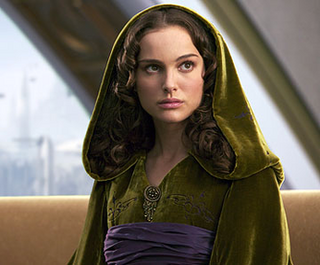
Padmé Amidala is a fictional character in the Star Wars franchise, appearing in the prequel trilogy and portrayed by Natalie Portman. First indirectly mentioned in Return of the Jedi, she is introduced in The Phantom Menace as the teenage Queen of Naboo, and after her reign, becomes a senator and an anti-war activist in the Galactic Senate. She secretly marries Anakin Skywalker, a Jedi Knight, then later dies while giving birth to twins Luke Skywalker and Leia Organa. Anakin's fear of losing Padmé serves as the catalyst in driving him to the dark side of the Force and becoming Darth Vader.

Lego Star Wars: Summer Vacation is a 2022 animated special based on the Star Wars franchise, and produced by Lucasfilm Animation and The Lego Group alongside Atomic Cartoons. Like The Lego Star Wars Holiday Special, it is directed by Ken Cunningham from a script written by David Shayne. A stand-alone sequel to the Star Wars sequel trilogy, the special was released on Disney+ on August 5, 2022.







